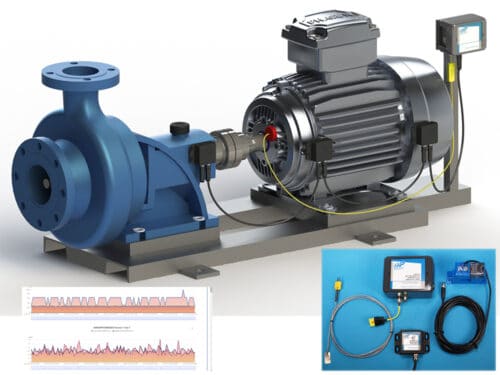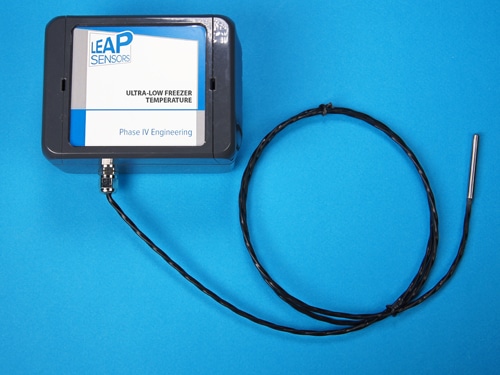-
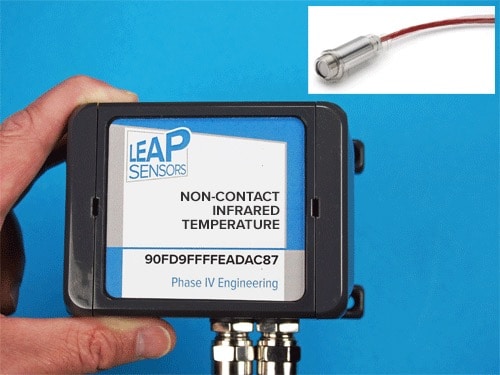 Ideal for monitoring temperature with a non-contact IR sensor. Standard model measures temperatures from -20C to 1000C with a 20:1 field of view. Contact us if you need an application specific wireless sensor with different specifications. Part of the breakthrough Leap Sensors® system. Build your quote here:
Ideal for monitoring temperature with a non-contact IR sensor. Standard model measures temperatures from -20C to 1000C with a 20:1 field of view. Contact us if you need an application specific wireless sensor with different specifications. Part of the breakthrough Leap Sensors® system. Build your quote here: -
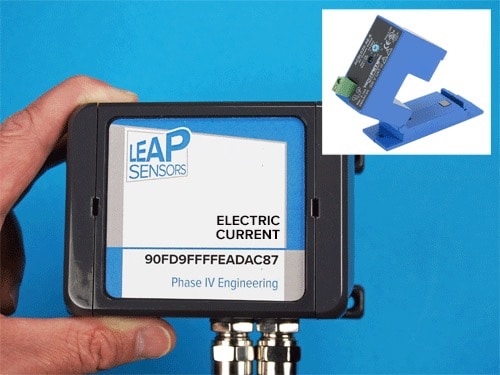 This Leap Sensor comes with a fast-to-install split-core AC amp clamp to sense the AC electrical current going to equipment. Amp clamps are a powerful industrial tool to monitor power usage and to monitor equipment for conditions that predict impending failures. A change in AC current to industrial equipment can be an early indication to plan downtime to prevent failures during production. A wide range of amp clamps can be integrated with the Leap system. Contact us with your specific needs.Price for 0-50A AC RMS current transformer. Contact us for pricing on other current transformer options.Contact Us
This Leap Sensor comes with a fast-to-install split-core AC amp clamp to sense the AC electrical current going to equipment. Amp clamps are a powerful industrial tool to monitor power usage and to monitor equipment for conditions that predict impending failures. A change in AC current to industrial equipment can be an early indication to plan downtime to prevent failures during production. A wide range of amp clamps can be integrated with the Leap system. Contact us with your specific needs.Price for 0-50A AC RMS current transformer. Contact us for pricing on other current transformer options.Contact UsPrices, Quotes, Questions...
Need a price or a quote? Have questions? Want to talk to an expert? Need a custom solution?Contact Us -
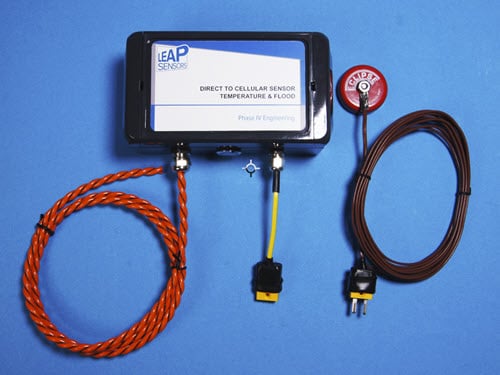 This wireless sensor communicates via a cellular transmission for remote temperature & flood monitoring. The internal antenna keeps the transceiver node small and resistant to damage. Sensor transceiver node combines standard mini k-type thermocouple connector for temperature sensing (wide temperature range) and a water sensor for flood detection. No gateway required – ideal for remote locations where standard sensors won’t work. Sensor node transmits via cellular link directly to cloud-based user interface. Receive alerts by email or text. “Practically battery-free”™ - Long battery life (up to 10 years, depending on application & transmission interval). Customize to your specific needs, including options to transmit only when designated thresholds are exceeded. Part of the breakthrough Leap Sensors system. Build your quote here:
This wireless sensor communicates via a cellular transmission for remote temperature & flood monitoring. The internal antenna keeps the transceiver node small and resistant to damage. Sensor transceiver node combines standard mini k-type thermocouple connector for temperature sensing (wide temperature range) and a water sensor for flood detection. No gateway required – ideal for remote locations where standard sensors won’t work. Sensor node transmits via cellular link directly to cloud-based user interface. Receive alerts by email or text. “Practically battery-free”™ - Long battery life (up to 10 years, depending on application & transmission interval). Customize to your specific needs, including options to transmit only when designated thresholds are exceeded. Part of the breakthrough Leap Sensors system. Build your quote here: -
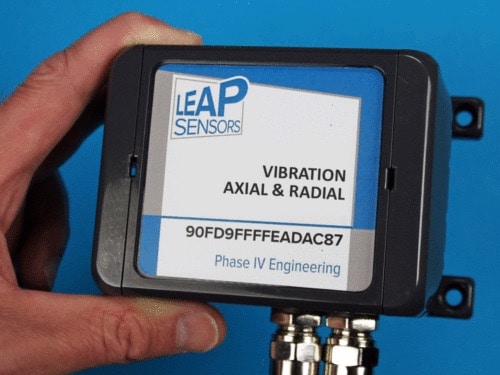 Vibration sensor can measure G-forces. Vibration sensor takes a simple yet highly effective approach in monitoring maximum and average g-force trends of +/-16G and can sample at up to 5 KHz on all 3 axes. The accelerometer has optional advanced on-board edge computing FFT capabilities. Customized options include vibration, tilt, and shock events. Up to 8 vibration modules can be attached to one transceiver node. The vibration module also includes a temperature sensor.
Vibration sensor can measure G-forces. Vibration sensor takes a simple yet highly effective approach in monitoring maximum and average g-force trends of +/-16G and can sample at up to 5 KHz on all 3 axes. The accelerometer has optional advanced on-board edge computing FFT capabilities. Customized options include vibration, tilt, and shock events. Up to 8 vibration modules can be attached to one transceiver node. The vibration module also includes a temperature sensor.Video Demonstration and Tutorial
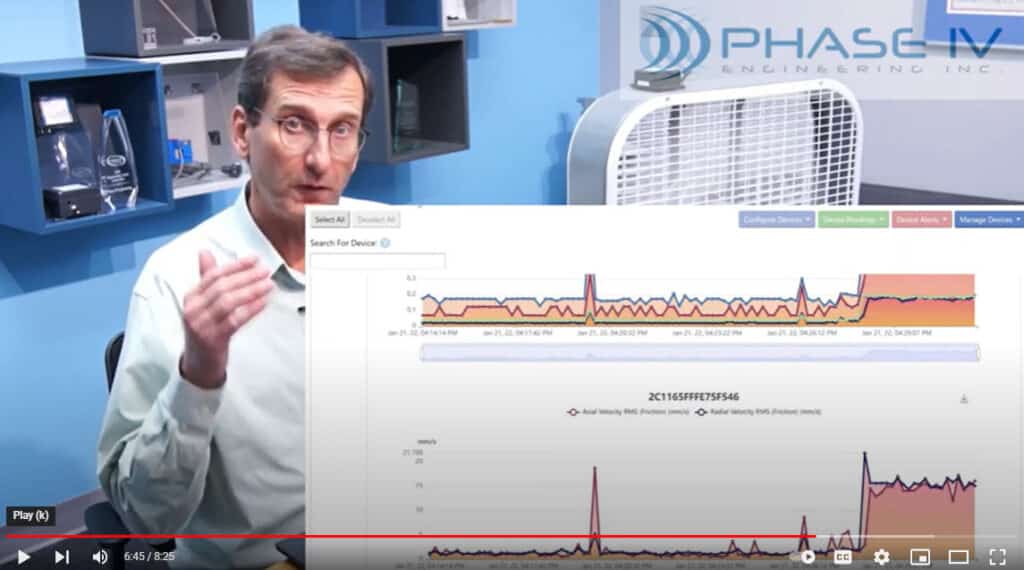
Transceiver Node Configuration
Vibration+Temperature Modules: The number of vibration/temperature modules (1-8) connected to the Vibration Transceiver Node can be selected on the vibration module page. Build your quote here: -
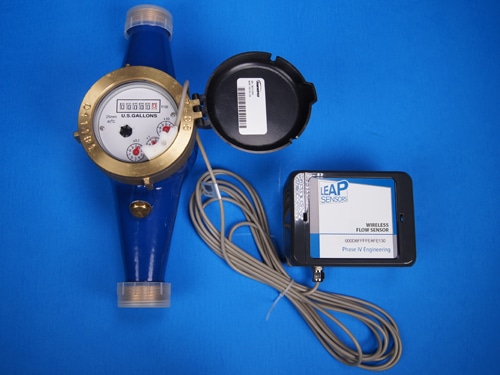 This groundbreaking sensor node integrates a discrete pulse flow meter to count units of flow (i.e. gallons, liters, etc) as liquid flows through a line. Unit can also be used as an incremental encoder for monitoring machinery speeds and total output. The transceiver node times individual pulses and their accumulated counts as they occur. It then uses edge computing to determine current flow rates and total volume of liquid passing through the meter. The edge logic also identifies when flow has stopped, duration of flow events, and duration of stop events. For ease of analysis, the node calculates both instantaneous rate of flow and its duration since the last sensor data reset, as well as a value to indicate if flow is currently occurring.
This groundbreaking sensor node integrates a discrete pulse flow meter to count units of flow (i.e. gallons, liters, etc) as liquid flows through a line. Unit can also be used as an incremental encoder for monitoring machinery speeds and total output. The transceiver node times individual pulses and their accumulated counts as they occur. It then uses edge computing to determine current flow rates and total volume of liquid passing through the meter. The edge logic also identifies when flow has stopped, duration of flow events, and duration of stop events. For ease of analysis, the node calculates both instantaneous rate of flow and its duration since the last sensor data reset, as well as a value to indicate if flow is currently occurring.- Monitors 11 different output variables, such as pulses, flow rate, total pulses, total volume, etc. See specifications for more details.
- Transceiver node is powered by a 120V wall transformer that plugs into a jack on the bottom of the enclosure (no battery powered options available.) Data is transmitted wirelessly via a gateway to the software.
- Connects to the Leap Wireless Sensor System with a secure 2.4GHz, FCC-certified radio.
- Count-reset button on top of the node enclosure resets the total flow at the end of a measurement period. Users can also set automated resets based on time of day.
- This unit is a variation of the Leap production counter, with modifications to account for flow measurement and volume totals.
-
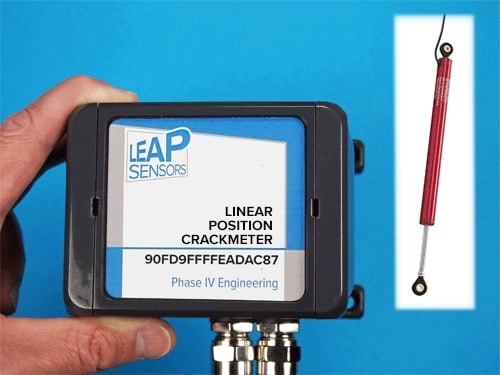 Sensor transceiver node designed to integrate with a wide range of linear position sensors and crack monitors with common outputs such as 0-5V, 4-20 mA, and RS485. The crack monitor is powered from the battery in the Leap transceiver node. When combined with a wireless transmitter, these sensors are very effective at monitoring changes in cracks or other movement over time in remote locations. Part of the breakthrough Leap Sensors® system. The linear sensor that meets your specific requirements will be integrated and tested with this device node. Contact us to find the best linear position configuration for your specific application. This external linear crack sensor is not included in this price but will be included in a final quote. Build your quote here:
Sensor transceiver node designed to integrate with a wide range of linear position sensors and crack monitors with common outputs such as 0-5V, 4-20 mA, and RS485. The crack monitor is powered from the battery in the Leap transceiver node. When combined with a wireless transmitter, these sensors are very effective at monitoring changes in cracks or other movement over time in remote locations. Part of the breakthrough Leap Sensors® system. The linear sensor that meets your specific requirements will be integrated and tested with this device node. Contact us to find the best linear position configuration for your specific application. This external linear crack sensor is not included in this price but will be included in a final quote. Build your quote here: -
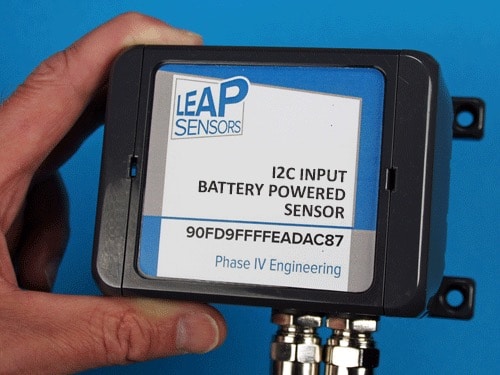 The Leap wireless pressure transceiver can integrate with every type of sensor with an I2C output. The sensor is powered by the Leap Sensor device battery with a power supply that can be specified from 3.6V to 24 volts. No external power source is needed. Contact us to let us help you make your selected I2C sensor wireless. Part of the breakthrough Leap Sensors® system. Contact us with the details of the I2C that you want to attach to the Leap Transceiver Node. Build your quote here:
The Leap wireless pressure transceiver can integrate with every type of sensor with an I2C output. The sensor is powered by the Leap Sensor device battery with a power supply that can be specified from 3.6V to 24 volts. No external power source is needed. Contact us to let us help you make your selected I2C sensor wireless. Part of the breakthrough Leap Sensors® system. Contact us with the details of the I2C that you want to attach to the Leap Transceiver Node. Build your quote here: -
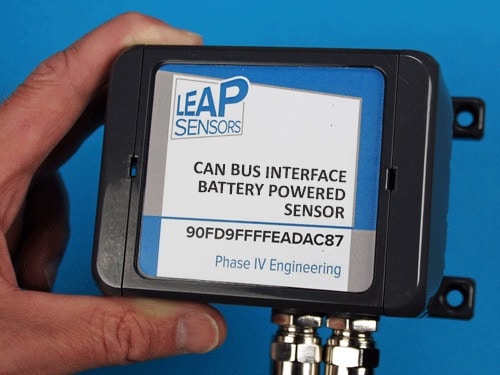 The Leap wireless transceiver can integrate with most sensors with a CAN bus interface. The sensor is powered by the Leap Sensor device battery with a power supply that can be specified from 3.6V to 24 volts. No external power source is needed. Contact us to let us help you make your selected CAN bus sensor wireless. Part of the breakthrough Leap Sensors® system. Contact us with the details of the CAN sensor that you want to integrate with the Leap wireless sensor system. Build your quote here:
The Leap wireless transceiver can integrate with most sensors with a CAN bus interface. The sensor is powered by the Leap Sensor device battery with a power supply that can be specified from 3.6V to 24 volts. No external power source is needed. Contact us to let us help you make your selected CAN bus sensor wireless. Part of the breakthrough Leap Sensors® system. Contact us with the details of the CAN sensor that you want to integrate with the Leap wireless sensor system. Build your quote here: -
 This very unique wireless sensor works by comparing the readings from one device node to another user-selected device node - then reporting the local pressure, local temperature - then differential pressure and temperature as compared to a user selected sensor. For example, sensor A is located outside at ambient temperature and pressure. Sensor B is located in a clean room under positive pressure and Sensor C is located in a different part of the cleanroom under a higher positive pressure. Sensor B could be configured to report its pressure and temperature and the differential pressure between Sensor B and Sensor A. (See the screen shot). Sensor C could be configured to report its pressure and temperature and the differential pressure and temperature between sensor C and sensor B. Sensor readings are reported in PSIA. Leverage the Leap SensorManager software to send text, email, or telephone alerts when a pressure, temperature, or delta-pressure or delta-temperature threshold is exceeded. Integrate the data from the differential pressure sensors into other software using our web-based API, Modbus, DNP3, or other data interface protocols. The wireless sensor can be configured with pressure sensors that have different ranges, resolutions, and accuracies for different applications. See the specification below for more information on the different options. Pressure sensors can be configured to specific applications. The pressure and temperature sensors in the photos have the pressure and temperature sensor sealed inside the enclosure with a pressure port in the back of the enclosure. Part of the breakthrough Leap Sensors® system. Build your quote here:
This very unique wireless sensor works by comparing the readings from one device node to another user-selected device node - then reporting the local pressure, local temperature - then differential pressure and temperature as compared to a user selected sensor. For example, sensor A is located outside at ambient temperature and pressure. Sensor B is located in a clean room under positive pressure and Sensor C is located in a different part of the cleanroom under a higher positive pressure. Sensor B could be configured to report its pressure and temperature and the differential pressure between Sensor B and Sensor A. (See the screen shot). Sensor C could be configured to report its pressure and temperature and the differential pressure and temperature between sensor C and sensor B. Sensor readings are reported in PSIA. Leverage the Leap SensorManager software to send text, email, or telephone alerts when a pressure, temperature, or delta-pressure or delta-temperature threshold is exceeded. Integrate the data from the differential pressure sensors into other software using our web-based API, Modbus, DNP3, or other data interface protocols. The wireless sensor can be configured with pressure sensors that have different ranges, resolutions, and accuracies for different applications. See the specification below for more information on the different options. Pressure sensors can be configured to specific applications. The pressure and temperature sensors in the photos have the pressure and temperature sensor sealed inside the enclosure with a pressure port in the back of the enclosure. Part of the breakthrough Leap Sensors® system. Build your quote here:

